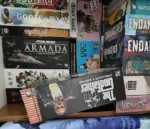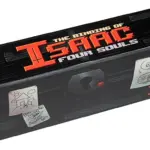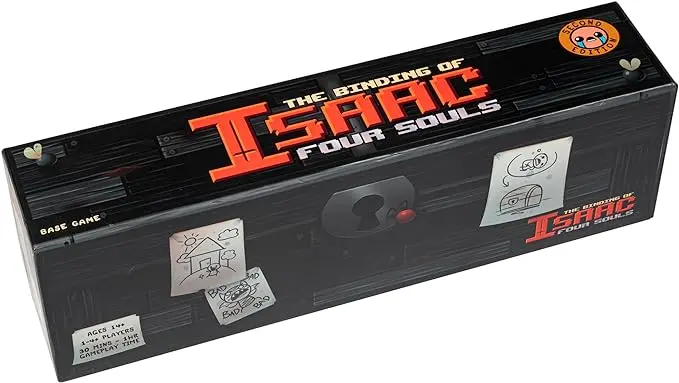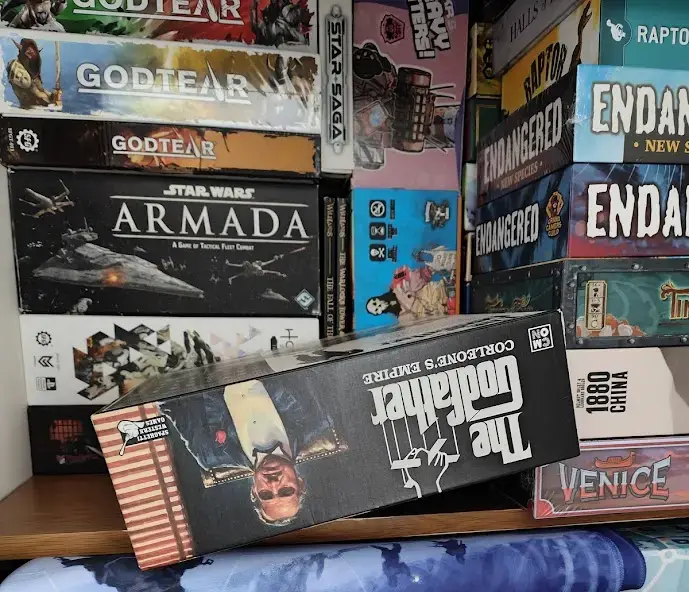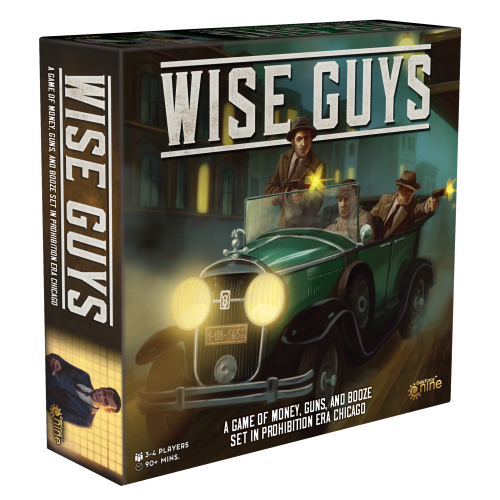The Binding of Isaac is a hugely successful videogame, and thanks to two extremely lucrative crowdfunding efforts that netted around $8 million, you could argue that its a highly successful card game as well. The videogame fits almost too perfectly into being turned into cardboard, with its roguelike genetics being suited to the randomness of dungeon crawler, variable bonuses and and player powers sitting well within the tabletop realm. There’s around eighty thousand people who have some kind of variation of the tabletop game. So surely its extremely good because well funded games are always amazing, aren’t they.
I’m approaching this as someone who is away from the hype canoe sailing down the river rapids of marketing and excitement and so this is probably going to be dull in comparison. I’m also someone who is a fan of the game, and has spent many an hour running around randomly generated dungeons of blood and filth.

For those unfamiliar with the videogame, you play as a collection of random babyish creatures who run around random dungeons with random weapons, facing off against random enemies before trying to kill a random big bad. Like most Roguelikes, Isaac rewards the player with repeated plays, and persistence, coupled in with the ability to deal with the occasional grotesque imaginings.
It is a game that induces a zen like state of play, where you react based on circumstances and sometimes runs play well for you other times you tap out. Runs being the key in this. Like Dead Cells, or Cult of the Lamb or Hades, you’re expected to graft and commit in order to see what the game offers beneath hidden layers and unlocks. All in all, Binding is one of those game where I’ll download it and play it for a few weeks before shelving it again but losing nothing at all by doing that.
The Binding of Isaac Tabletop game distils the roguelike element down to a deck of monster cards, loot cards and treasure cards, and has you playing against the upturned monsters of that particular round. Like the electronic version, players will use a random hero and persistent item to aid them in their quest to gain a total of four souls and win the game, but the game plays more like Magic the Gathering, where cards are activated for their powers and then recharged at the beginning of every round.
Everyone has the opportunity to use their character to play another loot card or interrupt another player’s turn. This is where the main bulk of the interaction and fun is going to take place. It is rare to want to play a secondary card in you own turn, and better to play it in order to do something inhibiting to your opponent. It’s fair to say that a lot of the loot cards in this game actually do very little for the player playing them, unless it is collecting cold hard cash.
It’s common for you to have more loot cards and purchased cards than you need as money is relatively easy to come by, and so it makes more sense to use them in someone else’s turn than sandbag them for your own benefit. Most of these interruptions are likely to occur when the player plays a card to help them take down one of the enemies they’ve decided to attack. At this point everyone has the chance to exhaust their hero and play a loot card that contributes to some kind of stack. The stack of cards are then actioned and resolved which can bring in damaging effects to the player taking their turn. Or benefit everyone around the table. It genuinely changes Isaac from a single player affair to a game that demands multiplayer in order to get the best out of the game and works all the better for it.
This comes into it’s own when players are fighting the enemies that reward a soul, as this is the win condition of the game, and collecting four of them grants victory and brings force the viciousness. There is an option to play the game with the bonus souls that require certain prerequisites to claim them and it is actually worthwhile bringing them in from the beginning. It adds that extra dimension of competition.
Even player elimination isn’t really player elimination. You’ll dust yourself down and lose some loot, but it plays into the spirit that losing isn’t really losing until you decide to pack everything away and decide to get the group back around to play again. Binding of Isaac demands that that play it with as many players as possible. The main mechanics of the stacking and interrupt work best at the highest player numbers you can get. There’s no real downside to playing a loot card when it’s not your turn and it perfectly fits into the theme of the game.
At lower player counts, it starts to fall into being a bit more of a pedestrian game, and to be honest, it doesn’t really create much excitement, which is a bit of shame. Ironically the single player version of the game is the weakest offering and least entertaining. I would tempted to advise you to just play the videogame if you’re wanting the Isaac single player experience. This is built for four or five fans of the game to gather round the table and appreciate the art and laugh at the in jokes included in the game. Which surprised me.
I’m surprised at the card only based format, when the game is pretty much ripe to be a dungeon crawler, but I can see how that would have been difficult to play with more than a couple of players. I was disappointed in the lack of polish in the overall package. With the level of money raised and the source material I was expecting a bit more Isaac in the overall product. There’s no round reminder cards in the game just keep things flowing as you take your first steps in the game. The rulebook is small and functional and ok. I was expecting a well illustrated, joyous homage to the videogame, with the expected dank humour and instead it’s small white sterile booklet. The coins are fine and plastic and could have been chunky and cardboard and cartoony.
There’s no damage hearts, and overall I feel like, yeah, it is labelled as the base game, but it feels like a pizza base without any of the wonderful toppings, considering what the game is based on. While the game feels random it doesn’t necessarily feel roguelike. You don’t feel like you are building up to any kind of big boss confrontation with no real sense of progression as per the videogame. You never really feel you have a sense of agency when you are playing and the game is more reactive than proactive.
The Binding of Isaac offers an abundance of player interaction with confrontation and crossing and double crossing. It thrives at higher player counts for those who don’t mind having their best laid plans ruined and returning the favour with spanners in return. Those expecting a cardboard version of their digital best friend might be confused in the direction the game has taken but if you have four souls to play this with, then it offers a fun card based time.
You can buy this game on Amazon and support us by going to https://amzn.to/3UpL3Kd
This review is based on the retail version of the game provided to us by an agent of the designer and publisher. We were not paid monetary compensation for this review. We give a general overview of the gameplay and so not all of the mechanical aspects of the game may be mentioned.
If you would like to support more content on the blog then please consider backing us on Patreon. www.patreon.com/werenotwizards

